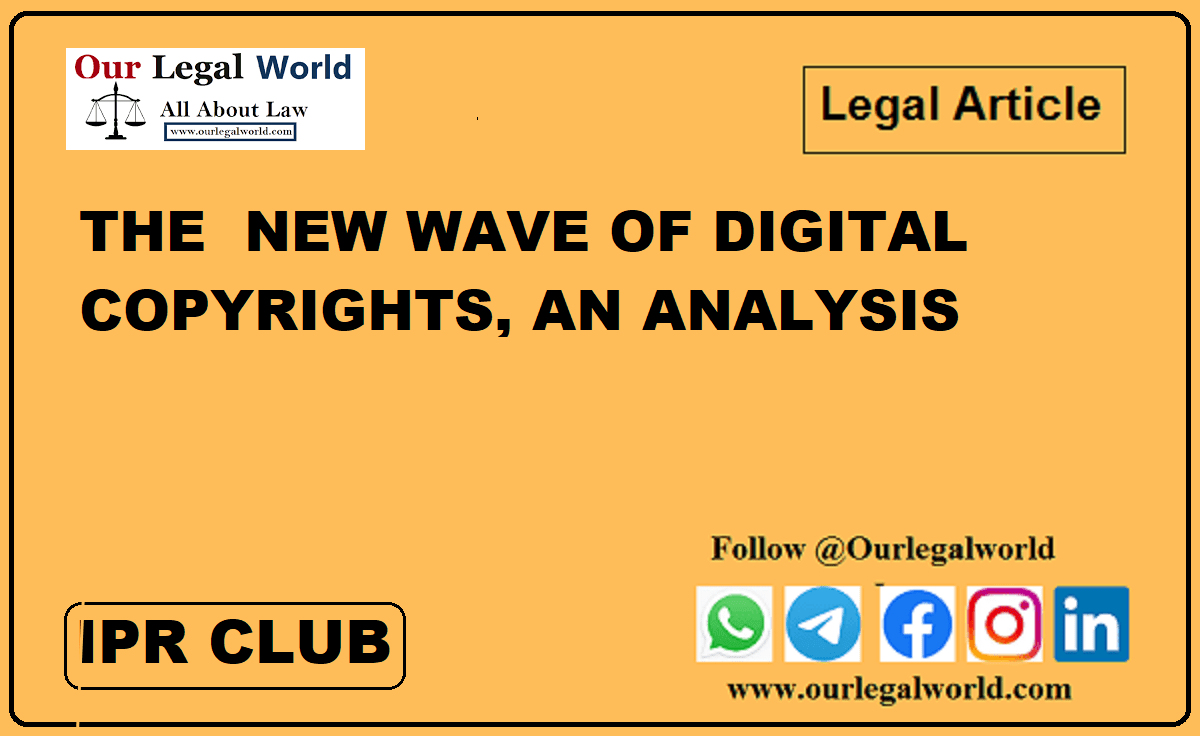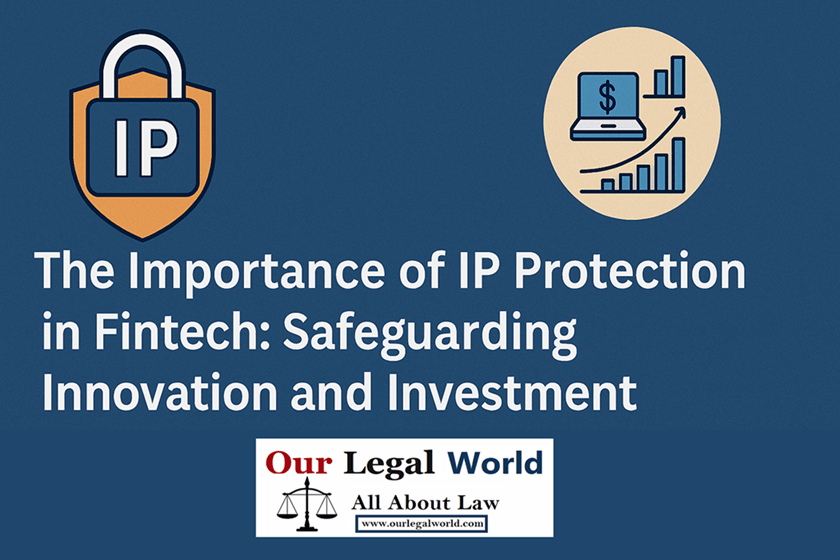THE NEW WAVE OF DIGITAL COPYRIGHTS, AN ANALYSIS
Written by: Evelyn Jeniffer.S
Copyright exists in the original work of authorship. With changes in time and technological developments, the medium of expression in which ‘work’ is stored or published has changed from conventional modes and mediums to digital means. Digitalisation has brought tremendous ease and convenience, naturally making the internet the most preferred medium of expression for communication and the exchange of ideas, content, creativity and innovation. As a result, information stored and uploaded on the internet has to be protected. The article throws light on different kinds of digital copyright and the ambit of protection and regulation in India.
Legal framework
The necessity to govern online content increased with the passage of time. Initially, there were challenges in regulating copyright in the digital environment. It was more difficult due to the nature of the medium of expression,( internet ) and the anonymity of users on the internet. As a response to the need and situation, the TRIPS agreement came into force in 1996. Further WIPO-endorsed ‘digital treaties. The WIPO Copyright Treaty and the Performance and Phonograms Treaty came into existence. Both of these Internet treaties brought in digital rights management and extended the then-existing Berne Convention and TRIPS provisions by allowing copyright holders to encrypt their work. It provides for the circumvention of technological protection measures (TPM), that protects unauthorized access and use of copyrighted content through technological circumvention. There are various technologies used by copyright owners to control access to their content like software locks, password control systems, time access and encryption measures. The concept of TPM has also been incorporated under the Indian copyright act through the 2012 amendment. Section 65A of the Act gives protection against circumvention, the provision penalizes under the act any person attempting to circumvent copyrighted content with the intention to defeat any of the exclusive rights of the copyright holder. And section 65B imposes criminal liability on any person who knowingly removes or alters any rights management information. Thus these treaties collectively provide a legal basis for the protection of copyright in digital media. It also ensures the continued protection of the rights of copyright holders even when their works are disseminated through new technologies and communication systems.
Computer programs and databases
Computer-generated works, software programs and databases are broadly classified as literary work to be brought under the ambit of copyrightable expression. In India, the Copyright Act 1957, under section 2(o) provides that “literary work includes computer programmes, tables and compilations including computer databases.” Computer databases are information stored in electronic form and computer software programmes are considered as intangible assets that are capable of yielding revenue. Section 13 recognises the extension of copyright protection to computer-oriented works through literary works. Section 14(b) upholds the exclusive right granted to creators of computer programmes that include the unique right to sale or commercial rental along with other commercial rights of reproduction, adaptation, communication of work to the public etc. Thus copyright subsists in a computer programme including databases, provided it qualifies to be of the original character. The debate however has always been around the fairness in recognising the compilation of databases as a matter of copyright and the war between sweat of the brow and modicum of creativity doctrines in evaluating the standard of originality. In the case of Feist Publications, Inc. v. Rural Telephone Service Company, Inc, the US Supreme Court differentiated between mere discovery and creation. The court held that in order to be original, the work has to have a minimum amount of creativity at least, thereby disregarding the copyrightability of .rural’s white pages which was a mere reproduction and compilation of feist’s telephone directories.
Also Read: DISTINCTIVENESS AS A FOUNDATIONAL STONE FOR REGISTRATION OF TRADEMARK
User generated content
UGC is one of the forms of digital copyright. Content that is developed by users and published in an online platform, in the form of a text, image, art , sound or video is known as user-created content or user generated content . OECD has given a definition as “i.) content made publicly available over the Internet, ii.) which reflects a certain amount of creative efforts, and iii.) which is created outside of professional routines and practices“. Everything on the internet nowadays, be it a writer’s blog article posted on a website or reels posted by a content creator on instagram or a tweet of a person on twitter, all of it all is protected under copyright provided that they qualify as an original work of authorship. Now to the million dollar question as to who owns the content on social media sites and who retains the copyright with respect to such content. The answer is that the User uploading the content retains the ownership and copyright of the UGC. Often sites that function through UGC, contain click-wrap license ,on acceptance of the said contract from the end of the user , the terms and conditions vest ownership of the content in the provider of the site.
In other words platforms such as Facebook, Instagram and Twitter allow posting of material that may be subject to copyright. These social media sites are only intermediaries. They do not own the work posted on their site, instead copyright is retained by the author or creator of the content. By posting their content on these social media websites, the authors sign an implicit agreement that gives the site a license to use the work and for displaying it. These licenses are non-exclusive and given worldwide, without any royalty. Although the author has granted a license to the social media platform to use that content on their platform, he can still control communication of his work by others, how it can be shared by others and who can share it. Hence any person other than the website owner(who has obtained the license) has to acquire a license from the owner of the content in order to use it. On the default of obtaining a lawful license sharing or re-posting of a copyrighted UGC, constitutes infringement. Reproduction and adaptation of the content are the most common form of online copyright infringement. The aggrieved copyright holder can seek remedy against the infringement through an action against the infringer claiming damages and royalty The DMCA in US and the IT Act in India provide for the way in which notice has to be served on the infringer to take down the content reported as a violation of copyright. The intermediaries however can escape the liability for third-party infringement claims through obtaining safe harbor immunity proving due diligence on their part.
NFT
NFT has probably become the second word in every minute that we hear now in the digital space. It has been gaining huge popularity amongst investors, artists, businessmen and financiers due to the market it has created. The sale of NFTs consisting of the famous crypto punk series has raised million-dollar revenue for the artists. But what exactly are these NFTs and how is it regulated ?. An NFT is a non-fungible token stored on a blockchain that represents an item in the physical world or digital world. Each token is specific to a unique item. The items can relate to artwork, music, videos, tweets, video game assets etc. NFTs are further secured through the technology of cryptography, such that the owner retains a private key which authenticates the access exclusive to the owner of the digital asset. The transfer of an NFT is enabled by effecting a smart contract. The ownership, transfer and licensing of NFT pose major challenges in the regime of intellectual property. The general norm in the transfer of NFT remains that only the right to title gets transferred to the buyer while the copyright and other commercial rights with respect to the said digital asset are retained with the creator. For instance, the NFT, “The First 5000 Days” owned by the auction house Christie was sold for 69 million dollars. The transfer gave effect to the conditions of the contract such that the buyer was entitled only with the right to display the artwork and the copyright of the NFT was rightfully retained by the seller. However, on the other end, it should also be noted that smart contracts can have different clauses embedded that can change the dimensions in which the IP rights of the buyer and seller are determined.
Conclusion
The Indian Copyright Act 1957 in itself is efficient in rendering protection to digital copyright. With the 2012 amendment, there are more safety provisions enabled, Digital copyright in the present world is dominated by user-generated content. Influencers and content creators who create content must be aware of their rights, responsibilities and remedy in case of infringement.
On the other hand, the usage of NFT invokes several laws including IP, taxation and consumer laws.However there is no solid regulation or guidelines governing the trading of NFTs in India. A better legal regime for the growing wave of new-age copyrights is indispensable.








